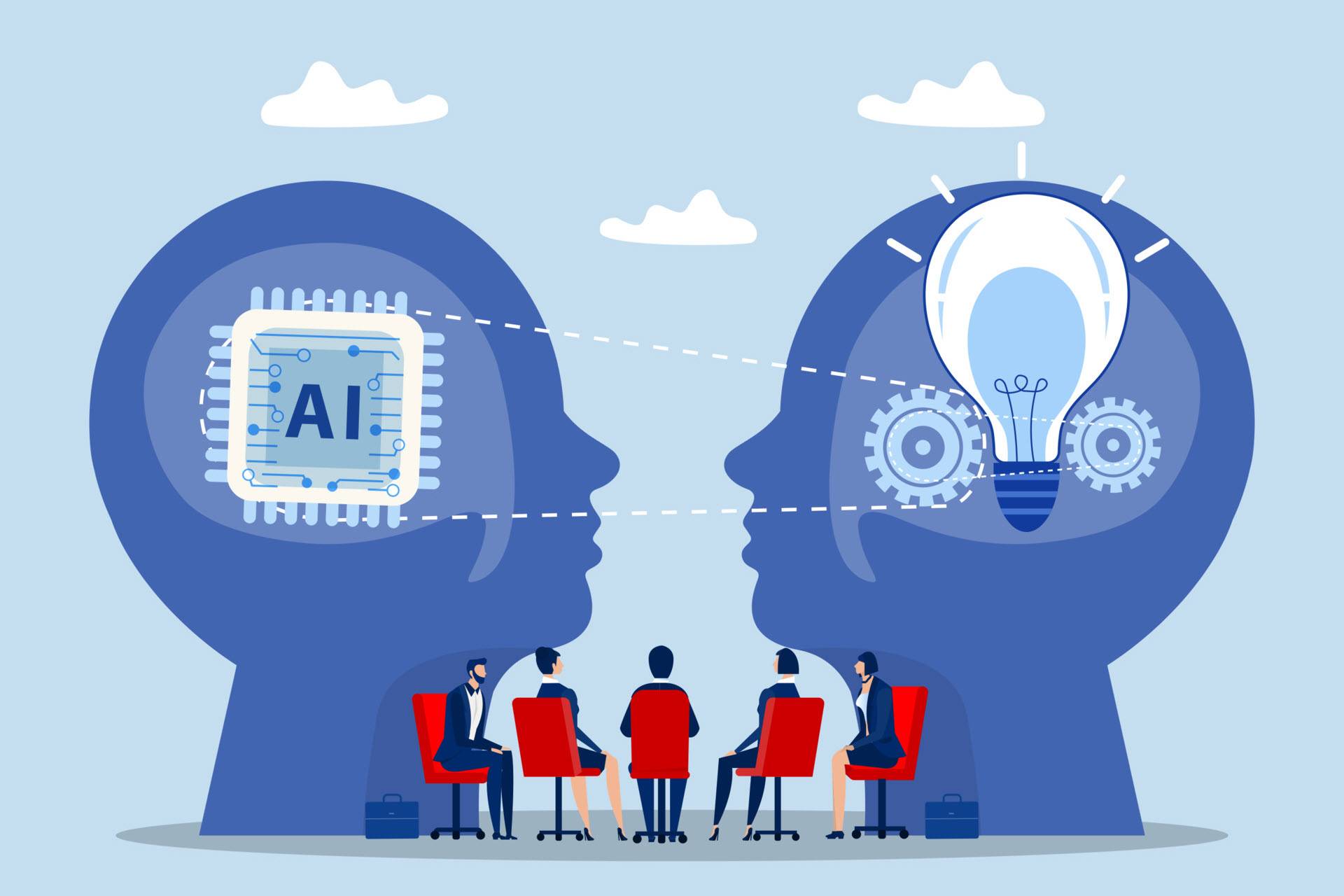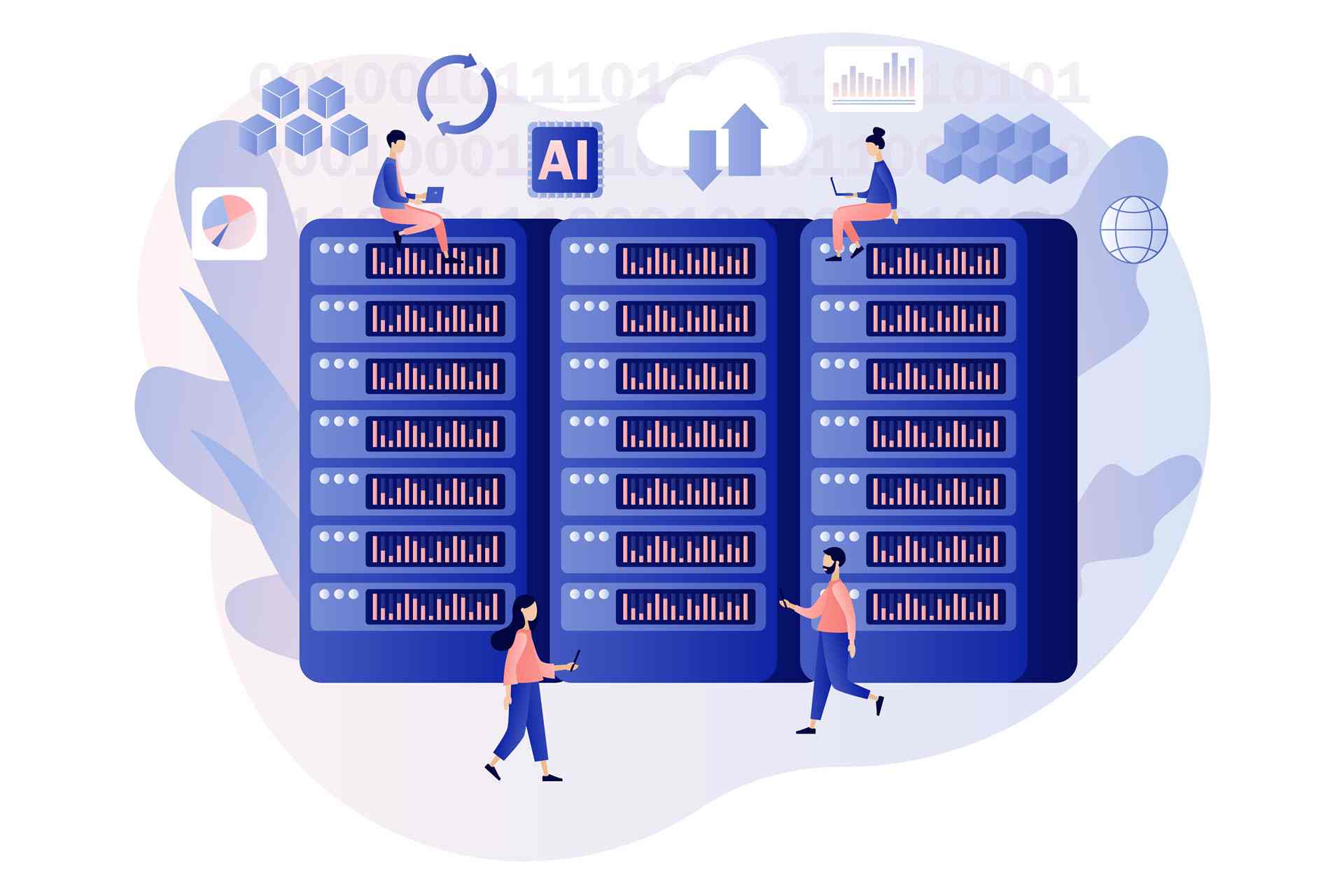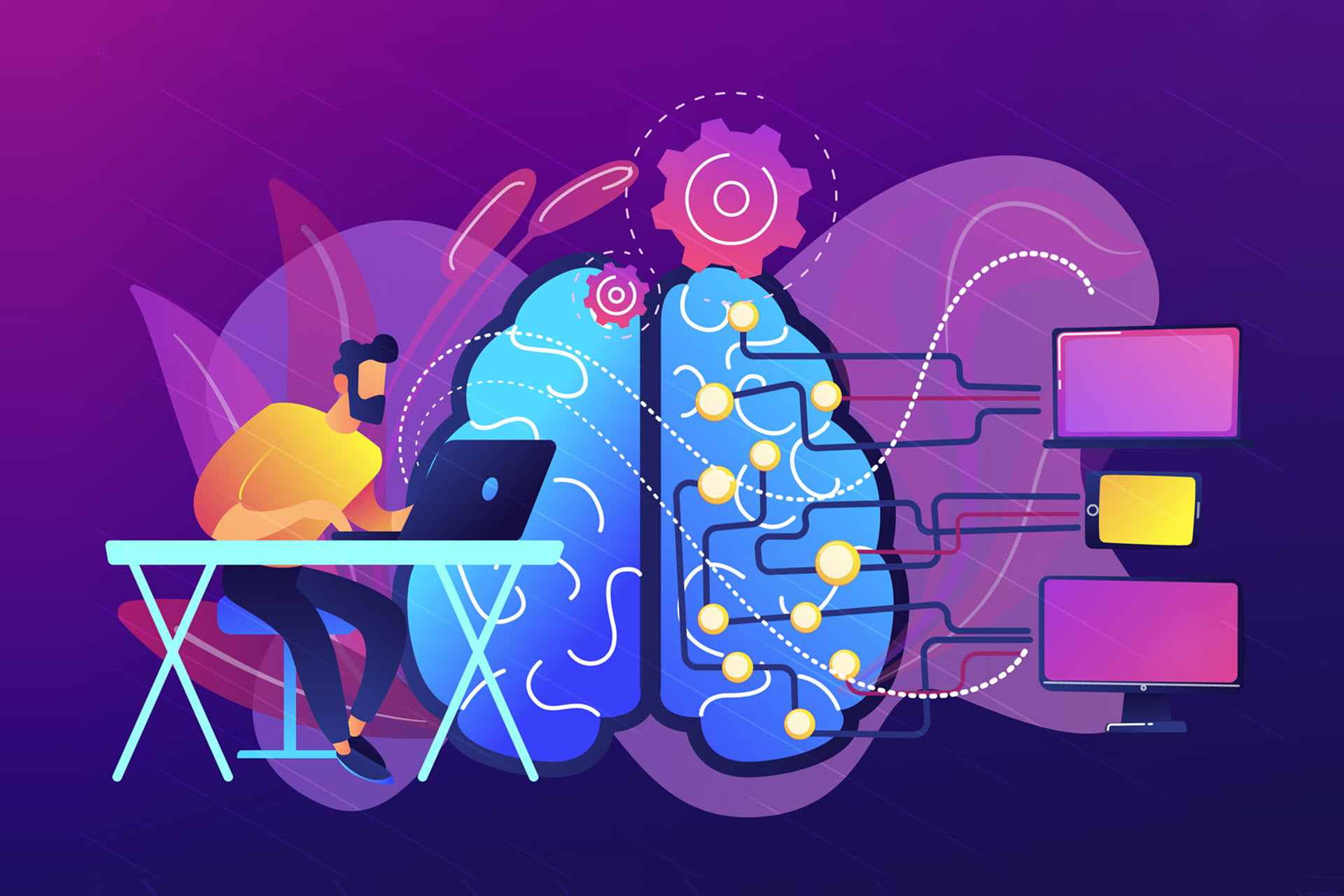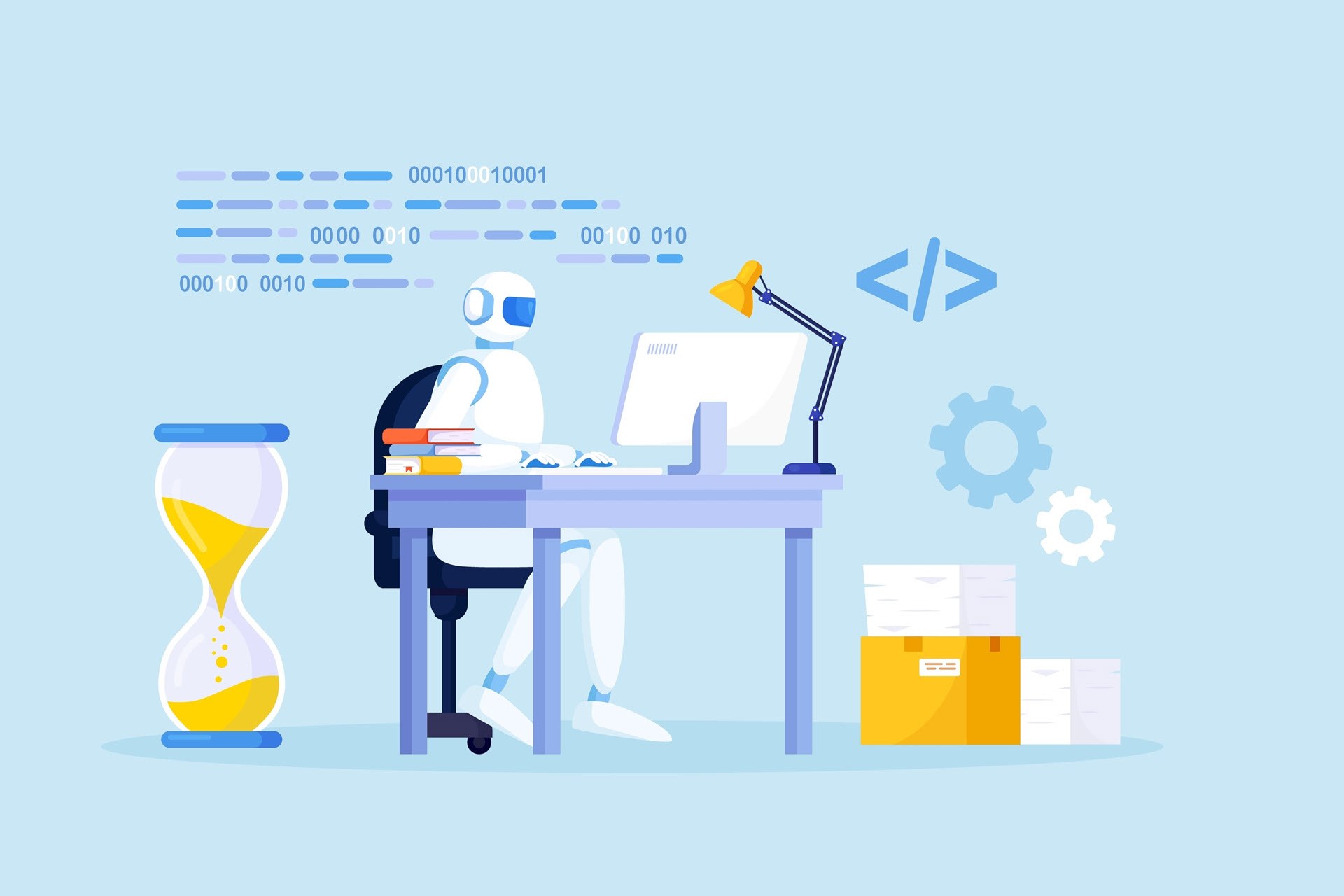As artificial intelligence (AI) continues to reshape workplace operations, many companies face a crucial decision: should they use widely available public AI platforms or deploy more expensive private AI models that offer greater control and privacy?
The choice between the two AI types depends on the model's purpose, available resources, and security needs. To make an informed choice, decision-makers must understand the main strengths and limitations of both public and company-controlled AI models.
This article presents an in-depth private vs. public AI comparison that helps identify the correct model type for your AI use case. Jump in to learn about the main differences between public AI tools (ChatGPT, Bard, Copilot, etc.) and private AI models that operate entirely behind a company firewall.
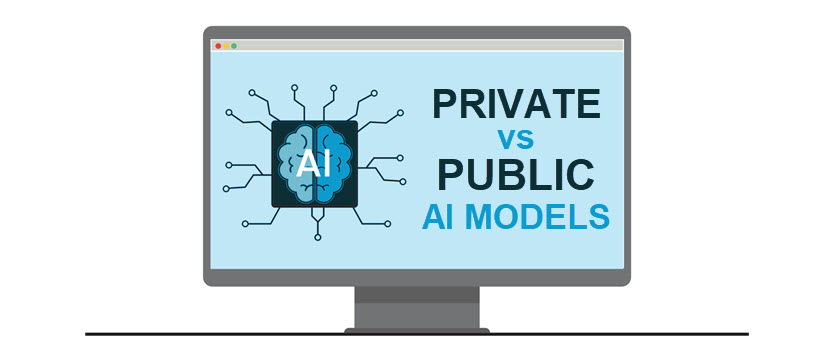
Planning to start using AI technologies at your company? Check out our guide to the business use of AI for some valuable guidance, but also read about the main AI risks and dangers to learn how to avoid the most common pitfalls of AI adoption.
Private vs. Public AI: Overview
The private vs. public AI comparison table below offers a high-level overview of the main differences between these two types of AI:
| Point of Comparison | Private AI | Public AI |
|---|---|---|
| Definition | AI models developed by and used within a single organization. | AI models open to public use. |
| Accessibility | Restricted to authorized users. | Available to anyone with an internet connection. |
| Infrastructure | Requires dedicated, privately owned infrastructure. | Hosted by third-party providers. |
| Deployment Time | Significant time for setup, training, and fine-tuning. | Immediate deployment, no setup required. |
| Customization | Adopters can train and fine-tune the model to their liking. | Allows limited prompt engineering, API customization, and embeddings. |
| Data Security | Enhances security since data remains on-site during its processing lifecycle. | Data processing occurs externally, which increases the risk of exposure. |
| Compliance Considerations | Keeping data on-site helps comply with regulations. | Third-party storage and processing of data increases the risk of violations. |
| Cost | High initial investment in infrastructure and considerable ongoing expenses. | Subscription-based; little to no upfront costs. |
| Scalability | Scaling up requires infrastructure investments. | Easily scalable thanks to cloud services. |
| Maintenance | Requires ongoing in-house maintenance and updates. | Handled by the third-party service provider. |
| Performance | Optimized for specific tasks. | Broad functionality; does not excel at specific tasks. |
| Latency | Low latency due to on-prem processing. | Cloud dependency may cause issues for high-frequency or real-time apps. |
| Integration | Requires custom development for seamless integration. | Easily integrates with cloud-based services and APIs. |
| Technical Expertise Required | High, requires in-house AI/ML expertise. | Minimal. |
| Updates | Manually managed by internal teams. | Automatic updates from the provider. |
| Reliability | Fully depends on internal IT resources. | Dependent on the provider's uptime guarantees and SLAs. |
| Vendor Lock-In Risk | Little to no risk. | Often locks users into specific ecosystems. |
| Use Cases | Proprietary data analysis, internal decision support, sensitive industry applications. | Chatbots, general text generation, code assistance, and research. |
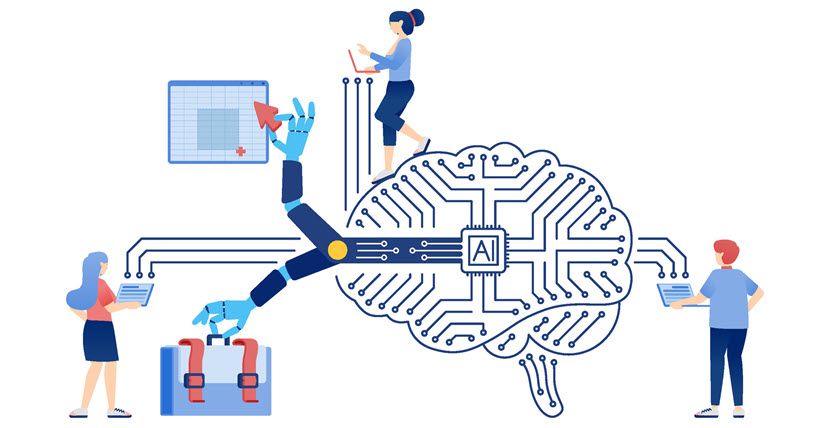
Private vs. Public AI: In-Depth Comparison
The following sections offer an in-depth look at the most notable differences between private and public AI models. Understanding these distinctions will ensure you choose the right AI type for your use case.
Data Security and Privacy
An AI model ingests, processes, and stores all inputs. Where that information goes and who has access to it is one of the primary differences between private and public AI.
Public AI operates on external infrastructure, so whenever a business submits a prompt or request, data processing occurs on the provider's servers. While vendors offer strict data handling policies, there's always the risk that the provider might repurpose, retain, or access input data.
Private AI, in contrast, keeps all processing on-prem, so data never leaves the organization's control. This trait eliminates third-party access concerns and ensures that sensitive data (e.g., customer details, financial records, IP info) remains within an in-house infrastructure.
From a cybersecurity standpoint, it's worth noting that public AI models are high-profile targets for attacks. The larger the provider, the more attractive they become for cyber attacks. Additionally, companies using the same public AI model share the same cloud computing space, so a vulnerability in one area could potentially impact other tenants.
Private AI does not eliminate cybersecurity threats, but it shifts control entirely to the company. Private AI models require strong internal security measures, though, so most adopters invest heavily in the following precautions:
- Data encryption (at rest, in transit, and in use).
- Tight access controls and authentication (OAuth, API keys, role-based access control).
- Adversarial attack protection.
- Monitoring systems tailored to specific risk profiles.
- Differential privacy.
- Federated learning.
- Zero Trust Architecture (ZTA).
- Continuous tracking of AI interactions and behaviors.
Using public AI also carries the risk of accidental exposure. Employees may unwittingly enter confidential info into a public AI tool, a risk that does not exist if you use an on-site private AI model.
Customization and Control
Public AI models are built for general-purpose use. While public AI offers some API-based customization, fundamental model changes are impossible. Instead, adopters must adapt to the core model rather than shape it to their needs.
On the other hand, private AI offers granular control over how the model behaves, what data it learns from, and how it interacts with other systems. If a company has a custom-built or open-source private model, the in-house team is free to:
- Use proprietary data sets instead of relying on broad, general-purpose training data.
- Adjust model parameters to optimize performance for specific tasks.
- Define how the AI responds to queries to ensure consistency with security policies.
- Access and modify internal logic to ensure explainability and compliance.
- Embed AI directly into existing systems, workflows, and custom applications.
- Decide when and how to upgrade, patch, or refine the model.
Another major distinction between private and public AI is transparency. Public AI often functions as a black box that offers little insight into why it generates certain outputs. In contrast, private AI enables adopters to:
- Access model parameters and internal logic to understand why it generates certain outputs.
- Adjust decision-making processes to align with internal policies and ethical standards.
- Conduct rigorous testing and debugging to refine responses and minimize errors.
Public AI also necessitates vendor dependence. If a provider changes prices, deprecates a tool, or alters functionality, businesses must adapt their operations accordingly. Private AI eliminates this dependence.
Organizations decide when and how to update their model, what features to prioritize, and how to evolve the AI over time. This self-sufficiency also reduces risks associated with vendor lock-in.

Regulatory Considerations
Public AI providers operate under broad, standardized policies that may not align with industry-specific regulations (e.g., HIPAA, GDPR, or SOC 2).
Adopters of public AI must trust a third party to handle compliance correctly, which raises the following concerns:
- Data residency. Public AI processes and stores data on external servers, often across multiple jurisdictions. This trait can conflict with regulations that require data to remain within specific geographic boundaries, such as GDPR or CCPA.
- Record-keeping and auditability. Many compliance frameworks require full transparency into how the AI model uses and stores data. Public AI's decentralized storage and processing complicates logging and compliance reports.
- Evolving policies. AI vendors occasionally update terms of service, privacy policies, and data handling practices. Each change can potentially create unexpected compliance risks.
On the other hand, private AI allows organizations to align their model with internal compliance policies and industry-specific legal requirements. All AI processing occurs on-prem, which simplifies efforts to comply with strict regulations. For example, GDPR's "right to explanation" requires AI adopters to provide understandable reasoning for the model's decisions. Meeting this obligation is considerably easier with private AI than with public models.
Private AI also enables full transparency, so organizations can track and document every AI decision and data interaction. Additionally, adopters can customize data storage, processing, and encryption to meet specific governance policies.
Some industries (e.g., finance, defense) have AI-specific guidelines beyond general data privacy regulations. A recent one is the EU AI Act, a first-of-its-kind legislation that introduces strict requirements for AI systems used within the European Union.
Scalability Considerations
Public and private AI take fundamentally different approaches to scalability. Both model types have distinct advantages and trade-offs.
Public AI runs on cloud-based infrastructure deployed within hyperscale data centers, a setup that enables on-demand and instant scalability. Businesses can scale up or down effortlessly, paying only for what they use, which offers the following benefits:
- There is no need to invest in additional hardware when scaling up.
- Scaling down doesn't mean the equipment you've already purchased will sit unused in your server room.
- The vendor handles the scaling process, which reduces the burden placed on the IT team.
However, scalability in public AI has some downsides. Ongoing usage fees become exponentially expensive at scale. Additionally, businesses may experience rate limits, slower response times, or restricted API access under heavy loads due to shared resources.
On the other hand, private AI requires more upfront investment in infrastructure, but it allows businesses to scale on their own terms. Companies can optimize computing power for specific workloads and avoid overpaying for unnecessary capacity.
Additionally, while the initial expansion is costly, scaling a private AI model does not involve recurring cloud or API fees. Companies are also not at risk of any usage limits or bottlenecks caused by other tenants.
On the downside, scaling up a private AI infrastructure always means acquiring more servers, which often involves improvements to the power and cooling infrastructure. IT teams must also actively manage resources during scaling, optimize the model, and ensure post-expansion system reliability.
You can scale your infrastructure in two ways: by upgrading the current machine with more or better components (vertical scaling) or by adding more servers to the resource pool (horizontal scaling). Learn the main advantages of both strategies in our horizontal vs. vertical scaling article.
Short and Long-Term Costs
Public and private AI models have different cost structures. Whereas public AI involves lower upfront costs but higher long-term expenses, private AI demands significant initial investments but provides greater cost efficiency in the long run.
Public AI appeals to businesses that want to deploy a model with little to no financial commitment. Since it runs on third-party infrastructure, companies avoid the cost of purchasing hardware. Most public AI providers charge based on usage (e.g., per query, API call, or token processed), making it cost-effective for low-volume projects or irregular usage.
However, public AI costs escalate rapidly as usage increases. Continuous usage leads to recurring expenses that eventually surpass the cost of setting up an in-house solution. Most vendors also charge extra for additional features (e.g., priority access, dedicated hosting, custom compliance options).
On the other hand, private AI requires significant initial investments as companies must deploy the required infrastructure and hire AI specialists. Here are the most notable short-term cost challenges of private AI:
- Infrastructure investment. Adopters must purchase high-performance servers, GPUs, and storage for model training and operation.
- Development and training costs. Creating a private AI model requires specialized expertise. At the very least, adopters must hire AI programmers, data scientists, and machine learning (ML) experts. Training a model also takes considerable time, so it takes a while to see profits from your model.
- Ongoing maintenance. Companies must allocate significant resources for day-to-day system upkeep, security, and improvements.
Despite high upfront costs, the lack of usage-based expenses means private AI becomes more cost-effective over time for high-demand applications. However, you still have to account for labor and operating costs (electricity, cooling, periodic hardware upgrades, etc.).
Ease of Deployment
Public AI platforms are pre-trained out of the box, requiring minimal effort to get started. Businesses can access APIs or web interfaces within minutes, eliminating the need for installation or hardware provisioning.
Public AI provides unparalleled speed and ease of use, enabling companies to rapidly test or deploy AI solutions. However, this simplicity comes with a trade-off in terms of control and customization, both of which are very limited.
Private AI offers more control but requires greater time and resources to deploy effectively. Here's what complicates the deployment of private AI models:
- Infrastructure setup. Private AI deployments require dedicated servers equipped with sufficient storage and powerful AI processors. Adopters must provision and set up these resources before deploying the model.
- Custom model development. Companies must either develop their own model or modify an existing one to align with their unique use case. This process can take weeks or even months for more complex projects.
- Integration with internal systems. Most adopters of private AI decide to embed their model into existing workflows. This process is time-consuming and prone to errors.
Logically, deployment complexity varies depending on model size. A small private model deploys faster than a large one that your team trains from scratch.
If you need immediate, low-effort deployment, private AI is not the right choice for your use case. However, if your use cases necessitate a private AI model, there are tools that automate parts of deployment and reduce setup time (e.g., Kubernetes or ML pipelines).
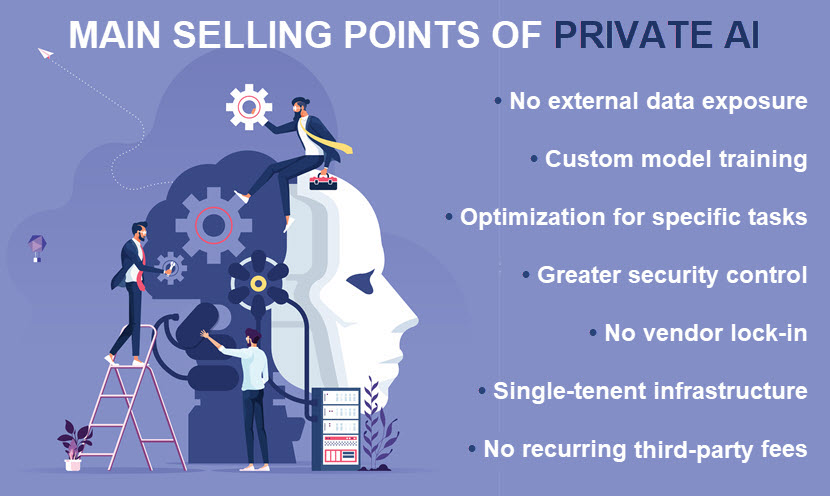
Day-to-Day Maintenance
Public AI is designed for effortless operation. Businesses can use the service without worrying about managing infrastructure, software updates, or performance tuning. The provider handles all maintenance tasks.
However, outsourced maintenance comes with a few trade-offs. Businesses must accept all provider changes, even if an update negatively impacts the AI model. Additionally, if the vendor experiences an outage or service degradation, users must wait for the provider to resolve the issue.
Adopters of private AI take full responsibility for the upkeep of their model and its infrastructure. The in-house team has complete control over updates, security, and performance tuning, so an average in-house AI team is in charge of:
- Provisioning servers, maintaining hardware, allocating storage, and optimizing networks.
- Installing patches, upgrading frameworks, and refining model parameters.
- Implementing security controls, monitoring for vulnerabilities, and ensuring regulatory compliance.
- Fine-tuning algorithms, retraining on new data, reducing biases, and optimizing response accuracy.
- Tracking latency, throughput, and resource utilization to prevent bottlenecks.
- Detecting and resolving system failures, threats, and unexpected errors.
- Expanding computing resources and optimizing workloads as AI demands grow.
On the downside, full control over day-to-day maintenance of the model leads to considerably higher operational expenses (OpEx) and the need for dedicated IT teams to manage the system. Your staff must also have advanced technical know-how to perform maintenance tasks effectively.
Model Specialization
Public AI models are trained on massive data sets that cover a wide range of industries and topics. These systems are designed to be highly versatile, making them useful for a range of tasks, including writing, summarization, coding assistance, and customer service.
Its broad focus means public AI has significant limitations for specialized tasks. Here are the most notable issues:
- Lack of domain-specific knowledge. While public AI understands many subjects, it may struggle with highly technical, niche, or proprietary prompts.
- Limited customization. Businesses must rely on off-the-shelf AI behavior, with few options for customization beyond basic model tweaks.
- Risk of overly generic or inaccurate responses. Since public AI is not tailored to a company's data or industry, it may provide overly simplistic or incorrect information.
Private AI enables adopters to optimize performance for specific tasks and operational goals. Businesses can fine-tune their AI models using internal data sets, ensuring sufficient expertise in company-specific processes, terminology, and workflows.
However, achieving sufficient levels of specialization requires time, effort, and expertise. Organizations must invest heavily in curating, cleaning, and structuring high-quality training data. Teams must also invest considerable time to train and optimize the model.
Reliability and Uptime
Public AI providers operate massive infrastructures with built-in redundancy and failover mechanisms spread across geographically distributed data centers. As a result, these providers often guarantee high availability for users.
However, businesses must trust the vendor to maintain uptime, as they have no control over outages or service disruptions. If a provider experiences an outage (e.g., API failures, server crashes, cloud outage, system maintenance), businesses are left with no choice but to wait patiently for a fix.
Reliable providers address issues swiftly, but unreliable ones may cause prolonged disruptions, which are a deal-breaker for mission-critical use cases.
Private AI eliminates reliance on external providers and allows businesses to maintain full control over uptime and model availability. As an extra benefit, adopters can design their own backup systems, failover protocols, and disaster recovery plans.
However, maintaining high reliability in private AI comes with a few challenges. Here are the most notable ones:
- Ensuring high availability levels requires 24/7 in-house monitoring, proactive server management, and effective incident response plans.
- If hardware fails or software malfunctions, there is no external provider to resolve the issue. The in-house team is fully responsible for the speed at which the model is back online.
- Achieving enterprise-grade uptime requires investing in advanced backup systems, load balancing, and failover mechanisms.
- Regular model retraining, software patches, and security updates are necessary to maintain performance and compliance.
Which AI Model Type Is Right for Your Use Case?
Public AI tools are ideal for companies seeking scalable and easily deployable solutions, while businesses in regulated industries or handling sensitive data often require the security and control that private AI offers. The best choice depends on your organization's priorities, so evaluate whether your use case justifies investing in a private model or if a public AI platform is a better fit.
The right choice depends primarily on your organization's priorities. Use the insights from this article to determine whether your use case justifies an investment in a private model or if a public AI platform is the better fit.
